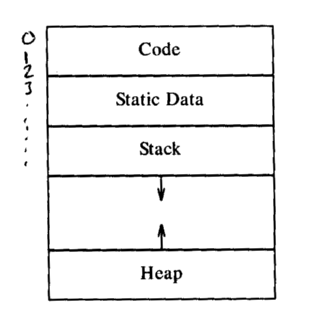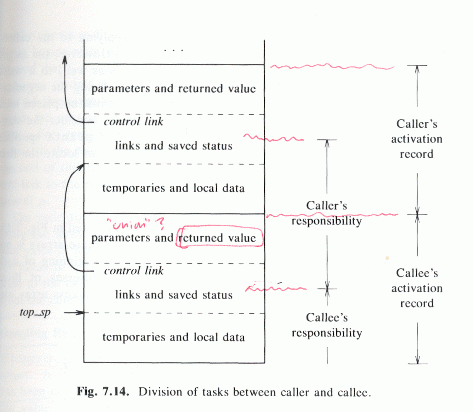Note: This is an outline of what I intend to say on the lecture.
It is not a definition of the course content,
and it does not replace the textbook.
Today: Run-time environments. More symbol tables. Memory management.
ASU 7.1-7.3, 7.6.
A paper about garbage collection:
The Very Basics of Garbage Collection.
KP chapter 4.
7 Run-Time Environments
What happens when the program is executed.
Especially how names in the source program,
like a variable called x,
is translated to memory locations.
7.1 Source Language Issues
Some terms:
- Procedure (including functions)
- Procedure definition
- Procedure name
- Procedure body
- Procedure call (Swedish: proceduranrop)
- Formal parameters = formal arguments = formals:
x and y in int f(int x, int y) { ... }
- Actual parameters = actual arguments = actuals
3 + 2 and n in f(3 + 2, n)
- Activation
- Activation record (Swedish: aktiveringspost) = frame
- Control stack
- Stack pointer, stack top (often kept in a register)
- Lifetime
- Recursive
- Control tree
- Scope (Swedish: räckvidd?)
- Local / non-local
- Data object
- Environment (Swedish: omgivning)
- Binding (of a name to a storage location)
7.2 Storage organization
Subdivision of Run-Time Memory
ASU Fig. 7.7. Typical subdivision of run-time memory into code and data areas.

The stack is cheaper than the heap.
Activation records
ASU Fig. 7.8. A general activation record.

Or, use registers for actual parameters and for the returned value.
Compile-time layout of local data
All this is determined at compile-time.
Each variable, such as the local variable i,
has a fixed offset in the activation record.
Fast to access, if a stack top pointer is kept in a register.
The compiler generates code to access i as (e. g.) SP - 24.
7.3 Storage-allocation strategies
- Static allocation
- Stack allocation
- Heap allocation
Static allocation
The compiler can decide the size and address of each data object.
If activation records are static => recursion difficult
(i. e., manage your own stack in a static data area).
Example: FORTRAN.
(But don't learn the FORTRAN details in this chapter for the exam!)
Stack allocation
ASU Fig. 7.13. Downwards-growing stack allocation of activation records

Call sequence (Sw: anropskonventioner), return sequence
What should the caller (= the callING procedure) do,
and what should the calle (=the callED procedure) do?
E. g., allocated the activation record, save registers.
Various call sequences exist.
In general, let the callED do as much as possible.
(Just code generated for that once, instead of for each call to it!)
ASU Fig. 7.14. Division of tasks between caller and callee.
Example:
- The callER evaluates actuals. (And stores them?)
- The callER stores a return address and the old SP in the new activation record,
and increments SP.
- The callED procedure saves registers and other status information.
- The callED procedure initializes local data + begins to execute.
The other way around when returning.

Variable-length data
Can be stored at the end of the activation record,
with just pointers to it among the local variables.
Dangling references
Possible with malloc + bad free,
but also with stack allocation.
Example:
char* getstr() {
char s[100];
fgets(s, sizeof s, stdin);
return s;
}
Heap allocation
malloc + free (or new + delete)
But also: activation records, if they have to be retained!
7.4 Access to non-local names
Can be skipped, but you may want to learn the difference between:
- Lexical scope = static scope
- Dynamic scope
7.5 Parameter passing
Can be skipped, but you may want to learn the difference between:
- Call by value
- Call by reference
- Copy-restore
- Call by name
- Macro expansion
7.6 Symbol tables
Very simple, from ASU chapter 2:
struct entry {
char *lexptr;
int token;
};
#define SYMMAX 100
struct entry symtable[SYMMAX];
int lastentry = 0;
Additionally:
- Type information
- Size (in memory)
- Location (= where in memory) (unless we are generating assembly language)
- Several entries with the same lexeme!
(Example: many procedures can have a local variable named i.)
= scope!
"Built during analysis, used during synthesis,"
We make a difference between:
- identifer (such as x)
- name (such as the name x of this variable, and the name x of that procedure)
Operations to handle scope in a block-structured language:
- begin_scope()
- find_name(x) - in the current block, and then the next outside, etc
- add_name(x)
- end_scope()
We can use a stack! (Push each new scope.)
But hash tables are much more efficient.
Characters in a name
Skip this. Too low-level.
Hash tables
Skip (page 433-438). You're supposed to know about hash tables already.
Representing scope information
7.7 Language facilities for dynamic storage allocation
Skip. Read
The Very Basics of Garbage Collection
instead.
7.8 Dynamic storage allocation techniques
Skip. Read
The Very Basics of Garbage Collection
instead.
Garbage collection
The Very Basics of Garbage Collection
Terms:
- Dynamically allocated memory (C: malloc, C++: new)
- Manual memory management (C: free, C++: delete)
- Garbage
- Why is manual memory management hard?
- Automatic garbage collection
- Live data / dead data
- Reachable data / unreachable data
- Root set
- Mark and sweep: mark bit, marking phase, sweep phase
- Reference counting
- Generational collection
- Conservative collection
- Incremental collection
Thomas Padron-McCarthy
(Thomas.Padron-McCarthy@tech.oru.se)
February 13, 2003




